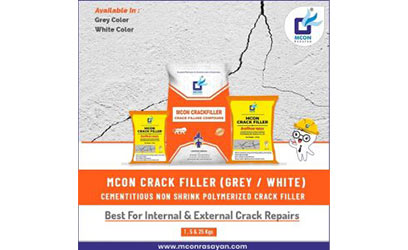 June 22, 2022
June 22, 2022
Cracks
CRACKS – The name itself suggests that something in wrong. Cracks are considered as an ill effect on everything that it takes place maybe a crack on the crockery, a crack in the glass door, a crack in the foot heel, a crack in the glacier, a crack in the relationship or a crack in the Construction finish. Today we are going to focus on the Crack in the Construction finish as for this particular crack, we have a solution from Mcon Rasayan in form of a Crack Filler with three variants:
- Crack Filler Powder (In Grey and White colour)
- Crack Filler Paste (IN White colour but can be pigmented)
- Crack Bond EP (Two Part Epoxy Crack filler with low viscosity)
Before jumping to the solution first lets understand the types of cracks that we face in the Construction finished products. The major or the most common types of cracks that we face are:
- Cracks in the Painted Surface – These cracks are mainly observed within 6 months to 2 years of the surface getting painted. The cracks are more predominantly seen in buildings which either have been plastered with traditional cement sand mix because throughout the building area its very difficult to maintain the right ratio of cement and sand. Also getting right quality of sand is very difficult. We can discuss the preventive measures to be taken to avoid these cracks separately. Now lets understand the remedial solution for Wall crack filling. These types of cracks need to be opened up in a V groove and filled up with Wall Crack filler.
- The Method of Application – Cut a V-notch 1⁄4to 1⁄8 inch (0.64 to 0.32 cm) along the crack. The “V” shape will help keep the compound in place.
- Remove the dust from the crack by brushing it out with a paint brush or using a hand vacuum cleaner.
- Apply coats of joint compound over the crack.Use a 3 to 4 in (7.6 to 10.2 cm) putty knife. Let the compound dry completely between coats.
- Layer on as many coats as necessary to fill the crack. The average is 3 coats.
- Drying can take from 20 minutes for each coat of setting-type joint compound to 24 hours for a thick first coat of pre-mixed compound
- Sand the dried joint compound with medium-grit sandpaper.Use a sanding block to smooth out the section to the flatness of the wall. Always wear a dust mask when sanding to avoid inhaling particles.
- The Wall crack filler to be used can be cementitious non shrink crack filler or a acrylic polymer based paste form crack filler. The wall crack filler to be used has to be decided based on the 3 parameters:
- The maximum size of the crack – if the maximum crack size is 10 mm then you can use both the crack fillers. Beyond 10 mm its more advisable to use Powder form Cementitious Wall crack filler.
- The final finishing you are planning – If the surface is going to be repainted post crack filling then you can use any of the Wall Crack Fillers but if you are not planning to paint it then its advisable to use Acrylic Wall Crack Filler Paste with proper tinting with Mcon Universal Stainer and avoid the zig zag shabby look of crack filling to the entire wall.
- CRACKS IN THE CONCRETE SURFACE – The cracks in the concrete surface especially flooring is a common problem faced in residential as well as industrial projects. The best way to repair cracked concrete is to use an epoxy resin crack filler. Repairing cracks in concrete can be a key part of extending the life of the concrete and preventing further damage from occurring as well as sealing the crack, Crack Bond EP will also seal and waterproof the surface ensuring a long-lasting finish that protects the concrete from weathering. is a strong, pourable epoxy resin liquid that will fill the concrete crack and then rapidly cure stronger than the concrete around it. The formula is composed of a low viscosity, two part, high strength resin. As it consists of 100% epoxy resin it is solvent free, unlike many cheaper alternatives.
- To clean a concrete crack, you should start by removing any large, loose pieces. This can be done with a chisel and hammer but be careful to only chip away loose pieces inside the crack and avoid making the crack bigger or causing damage to the concrete around it.
- Then, it is very important to clean the damaged concrete to remove any dust, laitance and debris. Use a wire brush or broom and then vacuum the crack as thoroughly as possible to ensure any the crack is clean and free of contamination. If your concrete is extremely dusty or perhaps very old, you may need to chemically clean it.
Don’t wait! Contact us to fix those cracks quickly and safely.
Contact Now
To mix, pour part B (the activator) of your two-part product into part A (the resin) and proceed to mix the parts together. We recommend use of an electric drill and stirring paddle attachment where possible. Ensure the base material and activator are thoroughly mixed and then pour immediately onto the cracked concrete. It is important to pour the formula immediately after mixing as the chemical reaction has begun and the resin will begin hardening.
Once the formula has been poured into the crack, ensure the crack is filled evenly throughout and where necessary use a Flooring Trowel to smooth the repair material into the crack and leave a flat, even finish. It is worth checking the crack after a few minutes to ensure the surface is still even, concrete cracks are often deeper than they first appear and some of the formula could sink through. You may need to add a little more and use the trowel to smooth again if the crack is not evenly filled.
Like any other country, India too has faced a fair share of climatic adversities in the past. While natural calamities are a big concern, a significant proportion of the country’s infrastructure is incapable of withstanding even acts of nature such as heavy rains. In the given situation its very important to follow a simple rule – A stitch at a time saves nine. Precaution is better than cure. So the moment cracks are visible in the wall we need to fill them with suitable crack filler and ensure that further ingress of water or moisture can be avoided. This will ensure that your structure remains well protected.
On timely identification of such cracks and adopting preventive measure are essential. Active cracks cause serious problems and they need special attention as they are structurally hazardous. So, it is important to understand the types of cracks, crack patterns and their causes and the preventive measures to be taken to control the cracks. Cracks affect the building’s artistic look and it destroys the wall integrity, affects the safety of structure and even reduces the durability of structure.
The cracks can be controlled if proper consideration is given to construction material and method to be used for its repairing.
Mahesh Bhanushali - Managing Director
As the Managing Director and Chairman of MCON Rasayan, Mahesh Bhanushali has spearheaded the company's growth into a premier construction chemical firm in India. His visionary leadership and commitment to technology-driven solutions have not only shaped the company's success but also established his reputation as a respected figure in the construction chemical manufacturing sector.
 June 22, 2022
June 22, 2022
